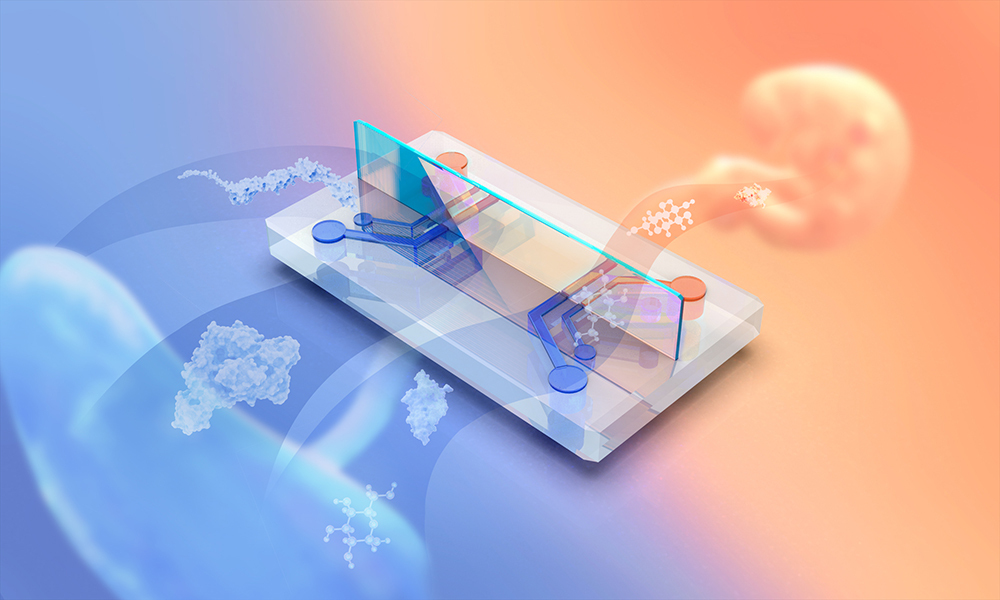
Read the latest Issue
A new model could serve as a platform to investigate critical placenta barrier phenomena, including defence against bacteria, viruses, and parasites

The placenta is a critical organ that develops during pregnancy, supplying oxygen and nutrients from the maternal blood to the fetus. The placental barrier serves as a filter for substances that cross from the mother to the fetus and vice-versa. And those substances can range from viruses, bacteria, or even drugs like ibuprofen or paracetamol.
A dysfunction in such vital structure can result in health complications for both sides. Pre-eclampsia is one such disease, usually associated with high blood pressure and vascular complications in the later stages of pregnancy.
“Up to eight per cent of pregnant people worldwide suffer from pre-eclampsia. For this reason, we need to build better humanised models in order to understand the causes of this and other placental dysfunctions,” stated Kristina Haase, Group Leader at EMBL Barcelona.
Haase and her group will be the first to build a 3D vascularised placenta barrier model on a chip. The chip is a small micro-scale device made from a flexible polymer with a central port wherein cells are grown and spontaneously form vessels inside. Around that port, there are several channels that allow researchers to supply various fluids and molecules of interest to the cells and analyse their development.
“Existing 2D placental models are missing a key component – a perfusable fetal vasculature – so we will build 3D chorionic villi,” said Marta Cherubini, the postdoc at Haase Group responsible for developing the model, about how this approach will enable scientists to understand what crosses the placental interface and the fetal bloodstream. “The chorionic villi are terminal branches that look like fingers and this is where the majority of fetal-maternal exchange occurs.”
The project, partly funded by the Spanish State Research Agency (Agencia Estatal de Investigación), is a collaborative effort with three main aims.
The first one focuses on creating a robust placental barrier on a chip. To protect the developing fetus during gestation, the placenta builds a continuous layer of specific cells known as trophoblasts, which separate the fetal vasculature from making direct contact with the maternal blood.
The 3D model that Haase and her group are developing is a pioneer one that has never been built before: this will be the first time to incorporate several human placental cell types including trophoblasts to generate fetal vessels and the interface layer. In normal conditions, the placental barrier allows for molecules (like sugars) to pass through it without impediments, yet larger proteins and cells from the maternal immune system are blocked. By controlling fluid flow and pressure in the vessels, the scientists will study how changes in mechanical signals influence and regulate the exchange of substances.
Once they fully develop the model, the second aim will be to study how properties of the placental barrier change when inflamed. The exact cause of pre-eclampsia is still unknown, but it is associated with significant inflammation. During gestation, women undergo blood tests to define their risk of pre-eclampsia, so although researchers don’t know what causes this complication, they do know several maternal plasma markers related to it. In collaboration with Dr. Elena Carreras and Dr. Manel Mendoza from Hospital Vall d’Hebron in Barcelona, the Haase group will collect plasma samples from patients from normal and pre-eclamptic pregnancies. They will then inject small amounts of plasma in the previously developed placental barrier on a chip, where they expect impacts on the barrier properties and fetal vascular remodelling.
Last but not least, the third aim is to understand the role of pregnancy-specific glycoproteins (PSGs) in fetal health. PSGs are the most abundant proteins secreted by placental trophoblasts into the maternal blood circulation during pregnancy. They have been linked to the proper development of maternal vessels in the placenta and modulate the immune system during gestation. Scientists have observed low amounts of PSG1 (a specific PSG) in the plasma of pre-eclamptic patients, and this condition is strongly associated with inflammation. In collaboration with Prof. Gabriela Dveksler at the Uniformed Services University of the Health Sciences in the United States, Haase and Cherubini will apply PSG1s on the maternal side of the device to study whether an increase of such proteins improves fetal health in an inflamed environment.
“A relevant 3D model of a human vascularised placenta will enable scientists to study this complex organ in a controlled and reproducible manner,” Cherubini said.
This work will focus on developing a novel in vitro tool that could uncover biological processes and functions of common obstetric complications in addition to pre-eclampsia.
“A robust human vascularised placenta model would open the door to study the effects of many other external factors such as drugs, Covid-19, or malaria, for instance,” stated Haase, envisioning new collaborations with both research institutions and biotech companies.
Looking for past print editions of EMBLetc.? Browse our archive, going back 20 years.
EMBLetc. archive